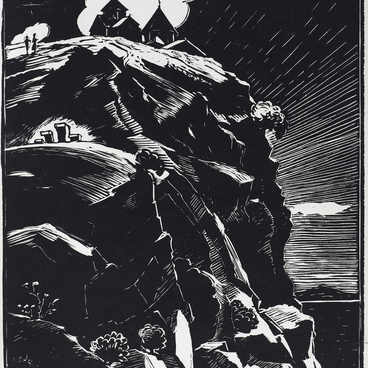The Irbit State Museum of Fine Arts presents Ivan Alexandrovich Kuznetsov’s linocut “The Flying Ship”.
Ivan Kuznetsov was born on May 23, 1908, in the village of Monetovo, the Vokhomsky district, the Kostroma region. He was the twelfth child in the family. The boy loved the spruce forests of his region dearly and took an interest in watching all kinds of forest animals. Every piece of paper he found, every wall that came his way became a canvas for him to depict what lived in his memory and imagination. After graduating from the peasant school in the village of Vokhma, Ivan decided to fulfill his most cherished dream — to receive further education. He got a job as a timekeeper for timber-rafting along the Vetluga and Volga rivers. The money he earned allowed him to get to Leningrad, but he did not manage to get a job there.
However, in 1925, Ivan Kuznetsov met the artist Yakov Ivanovich Brovar. Touched by the young man’s aspirations and believing in his skills, Brovar helped him by giving him money to travel to Moscow. In the capital, Ivan vagabonded, painting “from nature” in pubs and overnight shelters. A journalist of the Krestyanskaya Gazeta, who met Kuznetsov by chance, saw his drawings and decided to invite the young man to work for his newspaper. At first, Ivan was part of the expedition department of the newspaper, and his responsibilities only included pasting stamps and writing the subscribers’ addresses on parcels. Later, he was transferred to the department of rural correspondents. He began to accompany some of the notes with his drawings. The editorial staff liked them and appealed to the People’s Commissar for Education Anatoly Vasilyevich Lunacharsky with a request to allocate a place in an art educational institution to this capable young man. Lunacharsky forwarded the letter to the Rabfak (“workers’ faculty”) of Arts, where Ivan Kuznetsov was eventually enrolled. This was how Kuznetsov finally got to the Moscow Art Faculty at Vkhutemas.
Ivan Kuznetsov’s greatest penchant was for the wonderful world of fairy tales. Images of nature and beliefs of everyday life were familiar to him from an early age and came to life in his works. Many Russian people of the older generation remember thin books with his drawings from their childhood, such as “Geese and Swans”, “Sister Alyonushka and Brother Ivanushka”, and “The Goat with the Glass Eyes and Golden Horns”. Since the 1950s, collections of fairy tales illustrated by the artist have been published, such as “Mountain of Gems”, “Russian Fairy Tales”, “The Magic Ring”, “A Wonder Mill”, “Our Fairy Tales” and others.


